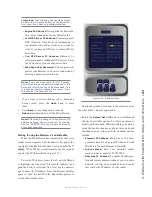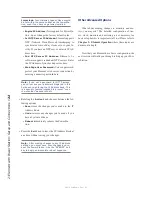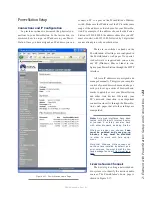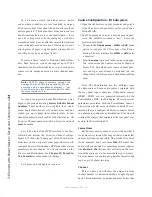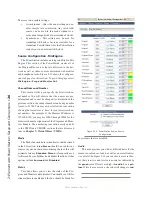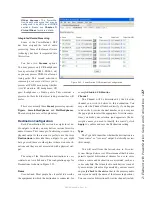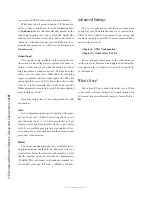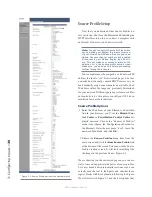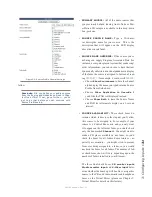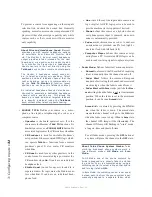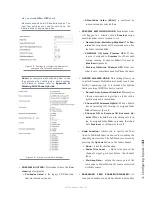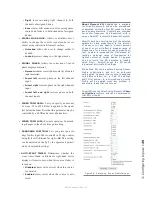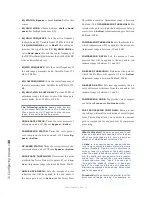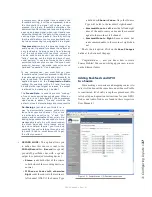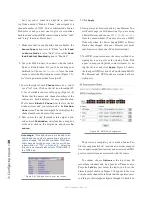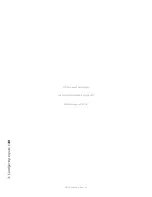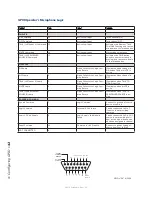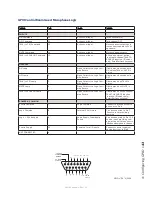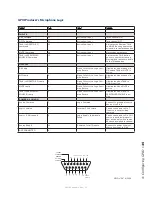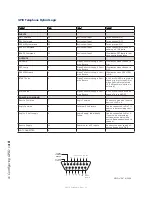
3: C
on
fig
uri
ng I
np
ut
s •
34
©2016 Axia Audio- Rev 1.8.1
source.
•
BACKWARD FEED DIM GAIN:
This is a feature
unique to Element: Talkback is sent over dimmed
backfeed audio. If you want a hard interruption
(Talkback interrupts Program audio), set it to OFF,
which mutes the audio. But maybe your jocks would
like to just have their program audio dimmed, and
the Talkback come over it so they can still monitor
air while they’re being talked to. In this case, input
a value by which the program audio will be dimmed.
Adjustment range is 0dB to -30dB.
•
LOGIC PORT DISABLED/EXCLUSIVE MODE/
SHARED MODE:
Allows you disable GPIO machine
logic to this audio source device or enable it in two
modes. Exclusive mode permits GPIO control asso-
ciated with only a single fader. Shared mode allows
more than one user to send on/off/start signals to a
source via GPIO.
•
GPIO READY ENABLED/DISABLED:
Allows de-
vices such as CD players or tape machines to sig-
nal their
READY
state to the operator through the
OFF button LED. If a device is cueing, its OFF lamp
will not be lit. Tying the device’s OFF lamp to the
Ready command means that a machine must be cued
and ready before the OFF lamp illuminates.
If
Enabled
, the OFF lamp illuminates only when the
fader is OFF and the Ready command is active on
the GPIO. If
Disabled
, the OFF lamp illuminates
normally whenever the fader is turned OFF.
•
FEED-TO-SOURCE MODE:
If there is a backfeed
associated with this source, this option determines
what content is fed back from the board.
»
Auto (Pgm-1/Phone)
feeds the Program 1 bus
(minus the source) when this source’s fader is
ON, and feeds the Phone bus (minus the source)
when the fader is OFF. The Phone bus is actually
a special variant of PGM4. The Phone bus is pre-
fader and pre-on/off to allow speaker-phone style
operation thru the Operator’s mic.
»
Phone
feeds the Phone bus, minus the source.
Phone is a mono-sum, pre-fade and pre-on/off
variation of PGM4
»
PGM1
feeds the Program 1 bus, minus the source.
»
PGM2
feeds the Program 2 bus, minus the source.
»
PGM3
feeds the Program 3 bus, minus the source.
»
PGM4
feeds the Program 4 bus, minus the source.
»
AUX SEND A
feeds the Aux Send A bus, minus
the source.
»
AUX SEND B
feeds the Aux Send B bus, minus
the source.
»
AUX SEND C
feeds the Aux Send C bus, minus
the source.
»
AUX SEND D
feeds the Aux Send D bus, minus
the source.
About the PHONE, RECORD and PROGRAM
4 buses: Element’s PGM-4 mix bus is a spe-
cial multi-purpose bus that does several things
at once to make life easier for the operator.
Sources assigned to PGM-4 are also sent to the
RECORD bus, a special post-fader, pre-on/off
output that can be used to feed recording de-
vices.
At the same time, sources assigned to PGM-4
are mixed and sent to the PHONE bus. PHONE is
an internal bus which does not feed a separate
output; instead, it picks up PGM-4 audio pre-
fader and pre-On/Off and backfeeds it callers
(minus themselves, of course) when the channel
is OFF and AUTO is selected as the Feed To
Source Mode.
Figure 3-5: Mode and Trim Source Profile Settings
•
SIGNAL MODE:
Determines whether source will be
treated as mono or stereo, and how.
»
Stereo
feeds incoming L/R signal to left and
right channels of assigned bus(es).
»
Left
feeds incoming left channel to both chan-
nels of assigned bus(es).
Содержание element v.2.0
Страница 100: ...5 Element Operations 90 2016 Axia Audio Rev 1 8 1 Capital budget may you never decrease for we need new test gear...
Страница 149: ...Appendix A Specifications 139 2016 Axia Audio Rev 1 8 1...
Страница 183: ...Warranty 173 2016 Axia Audio Rev 1 8 1 TCP IP How did we live without thee Analogicly...
Страница 184: ...THIS PAGE INTENTIONALLY LEFT BLANK...
Страница 185: ...THIS PAGE INTENTIONALLY LEFT BLANK...


